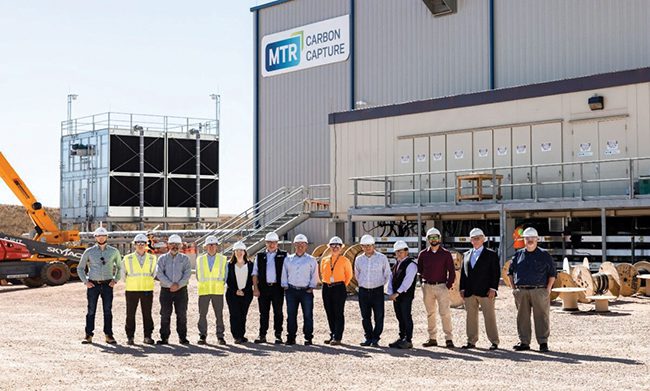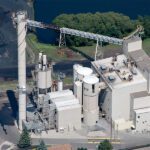Policy upheavals have cast uncertainty over the future of carbon capture and storage in the power sector, though its momentum is widely expected to continue.
In November 2024, the Global CCS Institute, an international think tank with headquarters in Melbourne, Australia, issued its annual overview of global progress for carbon capture and sequestration (CCS). In a departure from previous years, it paints a picture of significant growth and a renewed sense of forward movement for CCS technologies.
“2024 has seen significant growth in CCS facility development. 50 facilities are now in operation (3 of which are dedicated transport and/or storage projects), and 44 are under construction (7 of these are transport and/or storage),” the report says. As of July 2024, the pipeline includes 628 projects—a 60% year-on-year increase. “Both in facility count and capacity, the project pipeline has reached record levels,” it notes. “More significantly, the capture capacity of facilities under construction increased by 57%.” The “more than doubling of these projects in the past 12 months, from 121 to 247, is particularly noteworthy.” In addition, 222 transport/storage projects, which do not include capture, were in various stages of development, “showcasing significant capacity growth across all stages, including a 118% boost in the number of Advanced and Early Development projects.” Progress has been broad, with projects sprouting up in the U.S., Europe, the Middle East, China, and Southeast Asia, it notes.
The dramatic turnaround reflects a confluence of factors, including increasingly stringent climate targets, supportive government policies, technological advancements, and a growing recognition that CCS is indispensable for decarbonizing hard-to-abate sectors, said Jarad Daniels, Global CCS Institute CEO. A major driver has been collaboration. “The Institute has also identified over 50 bilateral agreements or memorandums of understanding (MoUs) executed by national governments since 2020 that include CCS within their scope,” he said. Still, while the growth is “very encouraging, we still have a long way to go to attain the gigatonnes per annum of carbon management deployment, both point source and CDR [carbon dioxide removal], required to help reach net-zero and avoid the most severe consequences of global temperature rise.”
For the power generation industry, these developments carry profound implications. Long seen as a major source of CO 2 emissions, the industry has faced a rollercoaster of pressure to reduce its carbon footprint, and the recent surge in demand projected in regions like the U.S. has pitted reliability against sustainability. Experts draw CCS as a pragmatic pathway that could allow the sector to continue utilizing its fossil fuel-fired power plants—for baseload and peaking power—while drastically reducing their emissions. But what is the true state of carbon capture in power generation, and can it truly deliver on that promise?
A World of Activity
So far, only a handful of power generation projects have begun commercial operation since SaskPower’s 115-MW Boundary Dam 3 in Saskatchewan, Canada, became the world’s first coal-fired power facility to implement carbon capture successfully in 2014. In 2017, Petra Nova near Houston, Texas, came online. After a pause, it returned to service in September 2023. Shenhua Guohua Jinjie Energy, a subsidiary of Shenhua Group, began operating a CCS facility at a coal-fired power plant located in the Jinjie Economic and Technological Development Zone in China’s Shaanxi province in 2021. In 2023, China expanded its CCS operations with Huaneng Yangpu Gas-Fired Carbon Capture Demo (0.002 million tonnes per annum of CO 2 [Mtpa]), a small-scale industrial capture project, and China National Energy Taizhou (0.5 Mtpa), which captures CO 2 from a coal plant for enhanced oil recovery (EOR).
Projects in the pipeline vary widely in scale and technology, ranging from pilot projects to large-scale commercial deployments. The largest projects include the Net Zero Teesside CCGT (combined cycle gas turbine) Facility in the UK (2 Mtpa CO 2) and the Drax BECCS project (8 Mtpa CO 2), both of which plan to store captured CO 2 in deep saline formations. In the U.S., key projects include Cal Capture (1.55 Mtpa CO 2, depleted oil and gas field storage) and Project Tundra, which, while still under evaluation, could capture 4 Mtpa CO 2. North America, notably, is seeing a rise in flexible, retrofit CCS projects, with facilities like the Starwood Energy Power Plant in the U.S. planning EOR as a storage solution, the report notes.
Regionally, Europe leads in CCS deployment. Multiple large-scale projects in the UK, Denmark, and Norway are slated to leverage deep saline formations and depleted gas fields for long-term CO 2 storage. Among much-watched projects are the Caledonia Clean Energy CCS project (3 Mtpa CO 2, UK) and the East Coast Cluster. In Asia, countries like China and South Korea are exploring CCS options, although most projects remain in early development. SK Energy’s Shepherd Project in South Korea remains under evaluation and is expected to be one of the region’s flagship efforts. While Asia-Pacific projects are diverse in approach, the lack of fully developed CO 2 transport and storage networks remains a key challenge.
Technology: Pushing the Boundaries
Technology-wise, post-combustion capture remains the dominant approach, particularly for natural gas and coal-fired power plants, with absorption-based systems leading in deployment. However, novel capture methods like oxy-fuel combustion and membrane separation are being explored in select pilot projects. As CCS continues to scale, advancements in low-energy solvent regeneration, non-amine solvents, and modular capture designs could enhance economic viability and efficiency (Figure 1).
 |
|
1. MTR Carbon Capture has completed the world’s largest membrane-based carbon capture plant at the Wyoming Integrated Test Center, set to capture 55,000 tonnes of CO2 annually from Basin Electric’s Dry Fork Station. The facility, which will begin operations later this year, marks a step toward scaling membrane-based carbon capture as an alternative to solvent-based systems. This photo shows MTR and Department of Energy personnel at the Gillette, Wyoming, site in September 2024. Courtesy: MTR |
“This landscape continues to evolve with technological advances happening in real-time,” Dr. Dipankar Sahoo, vice president for Technology and Energy Transition at Competitive Power Ventures (CPV), told POWER. “At CPV, our view is that carbon capture is the most technologically viable low-carbon solution for natural gas assets. We currently have over 5 GW of low carbon projects in development with the potential to utilize carbon capture technology,” he noted.
“At CPV, we have two CCGT projects in advanced development—the 2,060-MW CPV Shay Energy Center in West Virginia and 1,350-MW CPV Basin Ranch Energy Center in Texas—both designed and permitted with the option to include a carbon capture system,” he said. “We have several others in differing stages of development throughout the country. When the technology is viable, we intend to be a first mover.”
Sahoo pointed to several technology considerations CPV is watching:
-
Lower Regeneration Energy Requirements. Traditional amine-based solvents used for CO₂ capture require significant energy to regenerate, reducing the overall efficiency of the CCS process. Advancements in proprietary blended amines are showing promise in lowering these energy requirements.
-
Capital Expenditure (CapEx) Reduction. The high capital cost of CCS facilities is a major barrier to widespread adoption. Innovations aimed at reducing CapEx, particularly for the absorber unit, are crucial.
-
Lower Emissions. While CCS effectively reduces CO₂ emissions, it’s essential to minimize other emissions associated with the process, such as volatile organic compounds (VOCs) and nitrosamines, which can be more harmful.
-
Solvent Stability. Improving the stability of solvents is crucial for reducing solvent degradation and operational costs.
-
Non-Amine Solvents. Exploration of alternative solvents, such as metal-organic frameworks (MOFs), could offer advantages over traditional amine-based systems.
-
Flexible Operation. CCS systems that can operate independently of the power plant’s operation offer greater flexibility and can potentially improve overall efficiency.
While recent progress is encouraging, several challenges persist. “We do, however, need to complete the ecosystem around carbon capture to include pipeline permitting reform as well as developing a regulatory framework for carbon storage,” Sahoo said. Costs also remain a concern. To date, the business case for CCS investors remains heavily dependent upon regulations that price or limit CO 2 emissions, policies that create direct financial incentives for capturing and storing CO 2, or a combination of both. These have come in the form of Carbon Contracts for Difference (CCfD) schemes, government off-takes, investment tax credits, or direct capital injection.
“Commercially, adding carbon capture more than doubles the cost of a project without a revenue stream to offset that cost. With this in mind, efforts such as putting a price on carbon as well as the Inflation Reduction Act’s (IRA’s) 45Q tax provisions would support widespread adoption,” Sahoo said. “We support a national price on carbon, at a minimum, in the energy market. Through this, we would be able to help address the revenue challenge in a meaningful way. In addition, we are strong supporters of the IRA’s 45Q provision and believe tax incentives are a critical piece to moving this technology forward.”
Policy: The Key Enabler
In the U.S., at least, where the second Trump administration has now taken office, experts expect CCS will remain a critical tool, owing to its bipartisan appeal and the existing framework of incentives like 45Q tax credits. But according to Jessie Stolark, executive director of the Carbon Capture Coalition, while CCS deployment continues, regulatory and financial challenges remain key concerns.
“Based on President Trump’s own statements, it is our understanding that the EPA [U.S. Environmental Protection Agency] will be rolling back the Biden-era Clean Power Plan,” Stolark said. “While the Clean Power Plan recognized carbon capture technologies as a key pathway to reducing carbon dioxide emissions from existing coal and natural gas electric generating units, given the long lead times of installing carbon capture retrofits, it is our understanding that the Clean Power Plan’s use of carbon capture as the best system of emissions reduction, which was only finalized in mid-2024, was not yet a significant factor in utility planning.”
Despite anticipated policy rollbacks, industry demand for CCS remains strong. “A significant number of existing fossil-fuel-powered plants are still exploring installing carbon capture, regardless of the fate of these rules or other forthcoming rules to regulate the power sector,” she noted. The 45Q tax credit remains essential but needs urgent adjustments, she suggested. “To prevent further erosion of the credit value and sustain projects already in the development pipeline, 45Q must be immediately adjusted for inflation, using 2021 as the base index year for the dollar figure,” she said. “Adjusting the base index year to 2021 would provide a nearly 25% nominal value increase to the credit by 2026, consistent with the real credit levels intended by Congress through the introduction of bipartisan marker bills in 2021.”
Beyond tax incentives, Stolark stressed the importance of building market demand for low-carbon commodities. “Congress must expand its efforts beyond tax-based incentives for carbon management technologies. This means building market demand for products and services derived from carbon capture, removal, reuse, and storage. Growing domestic demand for the production of low-carbon commodities will foster greater competitiveness in global trade and help industries reach commercial maturity without being wholly reliant on federal support,” she added.
Stolark also pointed to infrastructure bottlenecks that could slow CCS deployment. “One critical step forward is to increase the number of states that can regulate storage,” she said. “Commercial-scale deployment of carbon management technologies requires a robust and responsible buildout of an interconnected, nationwide network of carbon dioxide transport and storage infrastructure.” Permitting reforms, particularly for CO 2 pipelines and storage sites, will be crucial to accelerating CCS deployment in the power sector, she said.
—Sonal Patel is a POWER senior editor (@sonalcpatel, @POWERmagazine).










